Early Childhood Education: TAFE NSW Planning Cluster Assessment 1
VerifiedAdded on 2023/04/07
|37
|6559
|429
Practical Assignment
AI Summary
This assignment focuses on the planning cluster in early childhood education and care, encompassing three units: establishing cooperative behavior, implementing inclusion strategies, and designing curriculum for children's learning. Task 1 requires creating a personal philosophy on early childhood education, addressing the image of the child, beliefs about play and learning, the role of families and community, inclusive practices, and professional development. Task 2 involves evaluating and comparing curriculum program formats, including an example provided and another sourced independently, to design a preferred format. The assignment emphasizes practical application and reflection on values and beliefs in the early childhood profession. Desklib offers this solved assignment and other resources for students.
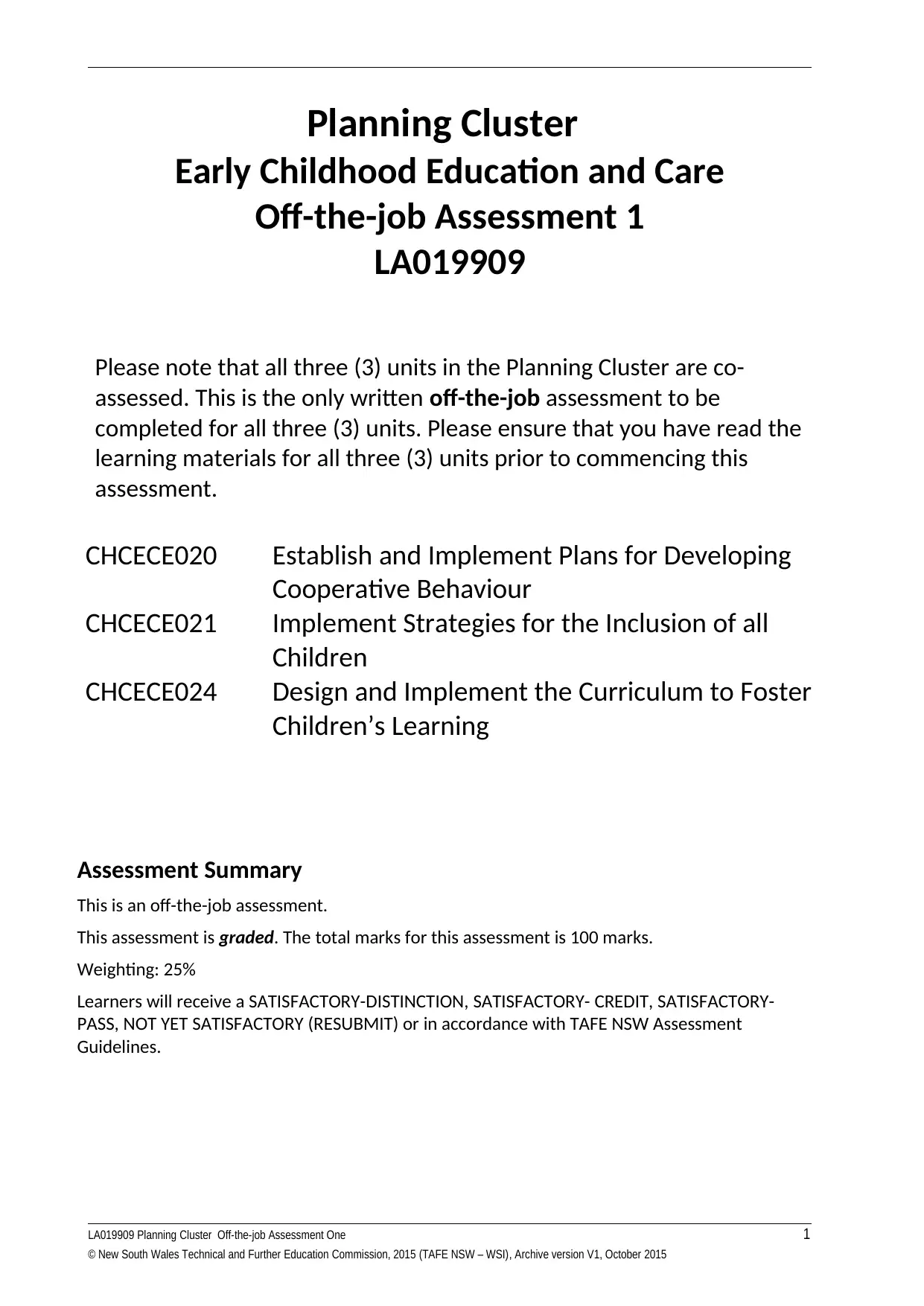
Planning Cluster
Early Childhood Education and Care
Off-the-job Assessment 1
LA019909
Please note that all three (3) units in the Planning Cluster are co-
assessed. This is the only written off-the-job assessment to be
completed for all three (3) units. Please ensure that you have read the
learning materials for all three (3) units prior to commencing this
assessment.
CHCECE020 Establish and Implement Plans for Developing
Cooperative Behaviour
CHCECE021 Implement Strategies for the Inclusion of all
Children
CHCECE024 Design and Implement the Curriculum to Foster
Children’s Learning
Assessment Summary
This is an off-the-job assessment.
This assessment is graded. The total marks for this assessment is 100 marks.
Weighting: 25%
Learners will receive a SATISFACTORY-DISTINCTION, SATISFACTORY- CREDIT, SATISFACTORY-
PASS, NOT YET SATISFACTORY (RESUBMIT) or in accordance with TAFE NSW Assessment
Guidelines.
LA019909 Planning Cluster Off-the-job Assessment One 1
© New South Wales Technical and Further Education Commission, 2015 (TAFE NSW – WSI), Archive version V1, October 2015
Early Childhood Education and Care
Off-the-job Assessment 1
LA019909
Please note that all three (3) units in the Planning Cluster are co-
assessed. This is the only written off-the-job assessment to be
completed for all three (3) units. Please ensure that you have read the
learning materials for all three (3) units prior to commencing this
assessment.
CHCECE020 Establish and Implement Plans for Developing
Cooperative Behaviour
CHCECE021 Implement Strategies for the Inclusion of all
Children
CHCECE024 Design and Implement the Curriculum to Foster
Children’s Learning
Assessment Summary
This is an off-the-job assessment.
This assessment is graded. The total marks for this assessment is 100 marks.
Weighting: 25%
Learners will receive a SATISFACTORY-DISTINCTION, SATISFACTORY- CREDIT, SATISFACTORY-
PASS, NOT YET SATISFACTORY (RESUBMIT) or in accordance with TAFE NSW Assessment
Guidelines.
LA019909 Planning Cluster Off-the-job Assessment One 1
© New South Wales Technical and Further Education Commission, 2015 (TAFE NSW – WSI), Archive version V1, October 2015
Paraphrase This Document
Need a fresh take? Get an instant paraphrase of this document with our AI Paraphraser

What you have to do:
TASK OVERVIEW
Task 1 Create your personal philosophy on Early Childhood Education and Care
Task 2 Evaluate the example curriculum format provided, collect and evaluate another
curriculum format and design a preferred format for your own use during work placement
Task 3 Provide useful community information on resources to support inclusion and
additional needs within a Children’s Service
Please read through all tasks very carefully before you begin.
Task 1
Personal Philosophy
(Total: 20 marks)
CHCECE024 – especially Topic 2
For this task you need to submit your own personal philosophy on Early Childhood Education
and Care.
As someone who is new to the field you will have already started to think about your values
and beliefs in regards to the Early Childhood profession. These may have been shaped by your
reading and recent work placement experiences. A personal philosophy is necessary to guide
and instruct your teaching practice. In keeping with current best practice and legislative
guidelines this philosophy should clearly describe your view of ‘the child’ and your
understanding of yourself as ‘the educator’. It should highlight your commitment to early
childhood pedagogy, knowledge of legal and ethical guidelines and inform your decisions on
responsive and inclusive programming and planning.
Your philosophy will be approximately one to three (1-3) pages in length. You may use
headings, statements and point form for your philosophy. It should provide a unique and clear
picture of your beliefs, values and vision regarding your chosen profession.
The Educator’s Guide to the EYLF (DEEWR, 2009) explains the importance of developing a
philosophy:
“Once we understand our beliefs and knowledge, we can make considered, wise choices in our
decision making in planning for supporting and reflecting on children’s learning.” (p 10)
Your philosophy will consider the following factors:
2 LA019909 Planning Cluster Off-the-job Assessment One
© New South Wales Technical and Further Education Commission, 2015 (TAFE NSW – WSI), Archive version V1, October 2015
TASK OVERVIEW
Task 1 Create your personal philosophy on Early Childhood Education and Care
Task 2 Evaluate the example curriculum format provided, collect and evaluate another
curriculum format and design a preferred format for your own use during work placement
Task 3 Provide useful community information on resources to support inclusion and
additional needs within a Children’s Service
Please read through all tasks very carefully before you begin.
Task 1
Personal Philosophy
(Total: 20 marks)
CHCECE024 – especially Topic 2
For this task you need to submit your own personal philosophy on Early Childhood Education
and Care.
As someone who is new to the field you will have already started to think about your values
and beliefs in regards to the Early Childhood profession. These may have been shaped by your
reading and recent work placement experiences. A personal philosophy is necessary to guide
and instruct your teaching practice. In keeping with current best practice and legislative
guidelines this philosophy should clearly describe your view of ‘the child’ and your
understanding of yourself as ‘the educator’. It should highlight your commitment to early
childhood pedagogy, knowledge of legal and ethical guidelines and inform your decisions on
responsive and inclusive programming and planning.
Your philosophy will be approximately one to three (1-3) pages in length. You may use
headings, statements and point form for your philosophy. It should provide a unique and clear
picture of your beliefs, values and vision regarding your chosen profession.
The Educator’s Guide to the EYLF (DEEWR, 2009) explains the importance of developing a
philosophy:
“Once we understand our beliefs and knowledge, we can make considered, wise choices in our
decision making in planning for supporting and reflecting on children’s learning.” (p 10)
Your philosophy will consider the following factors:
2 LA019909 Planning Cluster Off-the-job Assessment One
© New South Wales Technical and Further Education Commission, 2015 (TAFE NSW – WSI), Archive version V1, October 2015
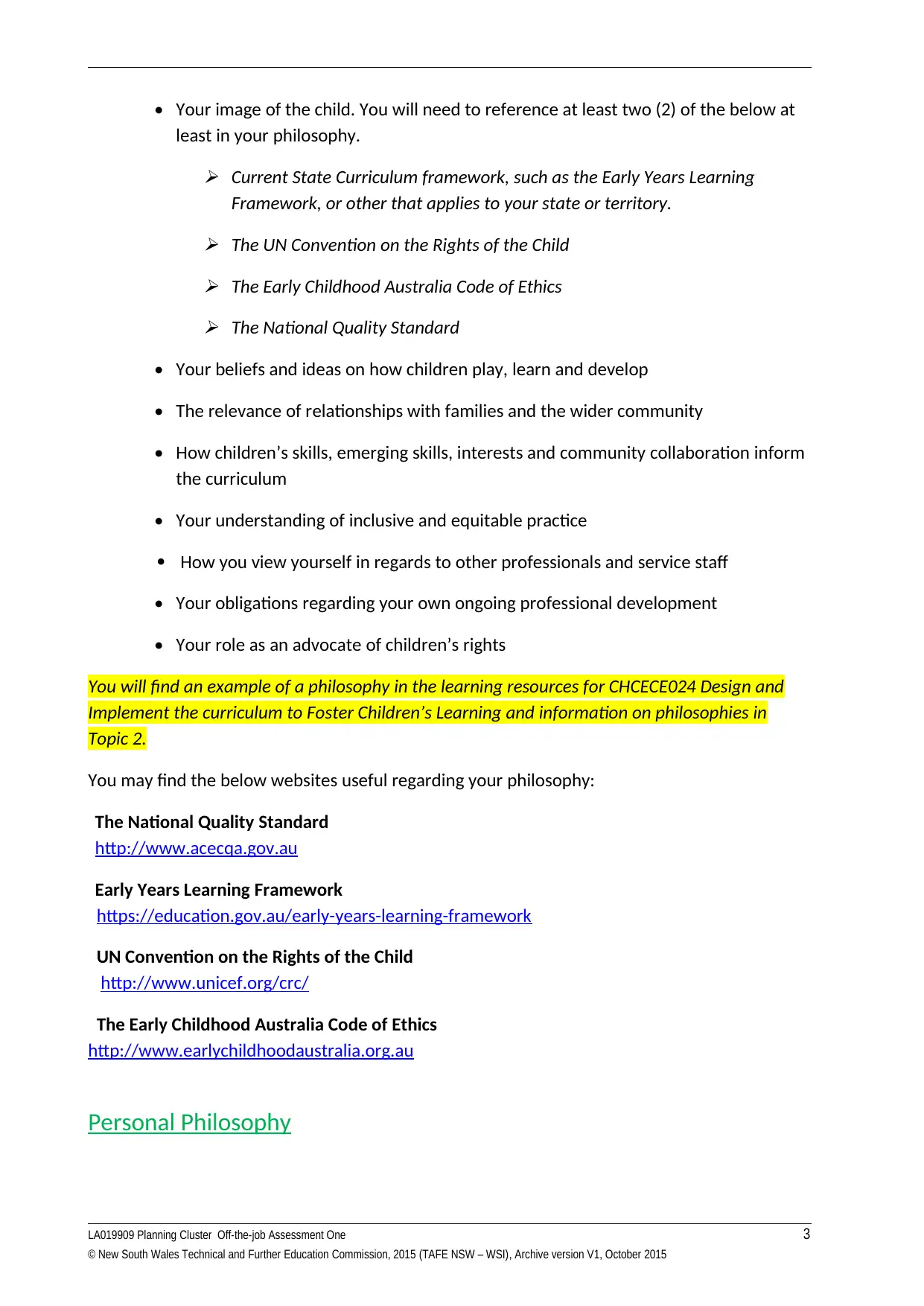
• Your image of the child. You will need to reference at least two (2) of the below at
least in your philosophy.
Current State Curriculum framework, such as the Early Years Learning
Framework, or other that applies to your state or territory.
The UN Convention on the Rights of the Child
The Early Childhood Australia Code of Ethics
The National Quality Standard
• Your beliefs and ideas on how children play, learn and develop
• The relevance of relationships with families and the wider community
• How children’s skills, emerging skills, interests and community collaboration inform
the curriculum
• Your understanding of inclusive and equitable practice
How you view yourself in regards to other professionals and service staff
• Your obligations regarding your own ongoing professional development
• Your role as an advocate of children’s rights
You will find an example of a philosophy in the learning resources for CHCECE024 Design and
Implement the curriculum to Foster Children’s Learning and information on philosophies in
Topic 2.
You may find the below websites useful regarding your philosophy:
The National Quality Standard
http://www.acecqa.gov.au
Early Years Learning Framework
https://education.gov.au/early-years-learning-framework
UN Convention on the Rights of the Child
http://www.unicef.org/crc/
The Early Childhood Australia Code of Ethics
http://www.earlychildhoodaustralia.org.au
Personal Philosophy
LA019909 Planning Cluster Off-the-job Assessment One 3
© New South Wales Technical and Further Education Commission, 2015 (TAFE NSW – WSI), Archive version V1, October 2015
least in your philosophy.
Current State Curriculum framework, such as the Early Years Learning
Framework, or other that applies to your state or territory.
The UN Convention on the Rights of the Child
The Early Childhood Australia Code of Ethics
The National Quality Standard
• Your beliefs and ideas on how children play, learn and develop
• The relevance of relationships with families and the wider community
• How children’s skills, emerging skills, interests and community collaboration inform
the curriculum
• Your understanding of inclusive and equitable practice
How you view yourself in regards to other professionals and service staff
• Your obligations regarding your own ongoing professional development
• Your role as an advocate of children’s rights
You will find an example of a philosophy in the learning resources for CHCECE024 Design and
Implement the curriculum to Foster Children’s Learning and information on philosophies in
Topic 2.
You may find the below websites useful regarding your philosophy:
The National Quality Standard
http://www.acecqa.gov.au
Early Years Learning Framework
https://education.gov.au/early-years-learning-framework
UN Convention on the Rights of the Child
http://www.unicef.org/crc/
The Early Childhood Australia Code of Ethics
http://www.earlychildhoodaustralia.org.au
Personal Philosophy
LA019909 Planning Cluster Off-the-job Assessment One 3
© New South Wales Technical and Further Education Commission, 2015 (TAFE NSW – WSI), Archive version V1, October 2015
⊘ This is a preview!⊘
Do you want full access?
Subscribe today to unlock all pages.

Trusted by 1+ million students worldwide
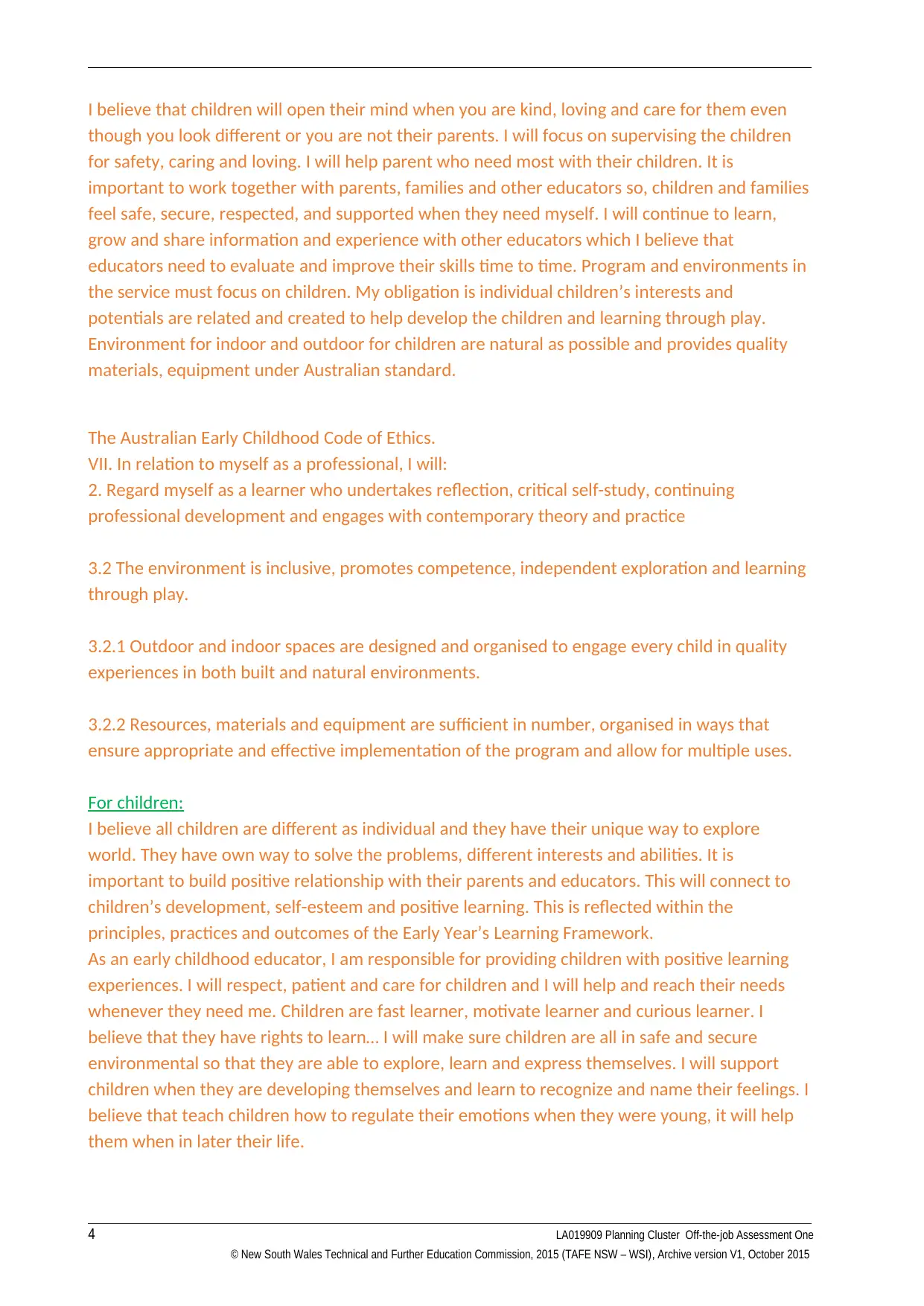
I believe that children will open their mind when you are kind, loving and care for them even
though you look different or you are not their parents. I will focus on supervising the children
for safety, caring and loving. I will help parent who need most with their children. It is
important to work together with parents, families and other educators so, children and families
feel safe, secure, respected, and supported when they need myself. I will continue to learn,
grow and share information and experience with other educators which I believe that
educators need to evaluate and improve their skills time to time. Program and environments in
the service must focus on children. My obligation is individual children’s interests and
potentials are related and created to help develop the children and learning through play.
Environment for indoor and outdoor for children are natural as possible and provides quality
materials, equipment under Australian standard.
The Australian Early Childhood Code of Ethics.
VII. In relation to myself as a professional, I will:
2. Regard myself as a learner who undertakes reflection, critical self-study, continuing
professional development and engages with contemporary theory and practice
3.2 The environment is inclusive, promotes competence, independent exploration and learning
through play.
3.2.1 Outdoor and indoor spaces are designed and organised to engage every child in quality
experiences in both built and natural environments.
3.2.2 Resources, materials and equipment are sufficient in number, organised in ways that
ensure appropriate and effective implementation of the program and allow for multiple uses.
For children:
I believe all children are different as individual and they have their unique way to explore
world. They have own way to solve the problems, different interests and abilities. It is
important to build positive relationship with their parents and educators. This will connect to
children’s development, self-esteem and positive learning. This is reflected within the
principles, practices and outcomes of the Early Year’s Learning Framework.
As an early childhood educator, I am responsible for providing children with positive learning
experiences. I will respect, patient and care for children and I will help and reach their needs
whenever they need me. Children are fast learner, motivate learner and curious learner. I
believe that they have rights to learn… I will make sure children are all in safe and secure
environmental so that they are able to explore, learn and express themselves. I will support
children when they are developing themselves and learn to recognize and name their feelings. I
believe that teach children how to regulate their emotions when they were young, it will help
them when in later their life.
4 LA019909 Planning Cluster Off-the-job Assessment One
© New South Wales Technical and Further Education Commission, 2015 (TAFE NSW – WSI), Archive version V1, October 2015
though you look different or you are not their parents. I will focus on supervising the children
for safety, caring and loving. I will help parent who need most with their children. It is
important to work together with parents, families and other educators so, children and families
feel safe, secure, respected, and supported when they need myself. I will continue to learn,
grow and share information and experience with other educators which I believe that
educators need to evaluate and improve their skills time to time. Program and environments in
the service must focus on children. My obligation is individual children’s interests and
potentials are related and created to help develop the children and learning through play.
Environment for indoor and outdoor for children are natural as possible and provides quality
materials, equipment under Australian standard.
The Australian Early Childhood Code of Ethics.
VII. In relation to myself as a professional, I will:
2. Regard myself as a learner who undertakes reflection, critical self-study, continuing
professional development and engages with contemporary theory and practice
3.2 The environment is inclusive, promotes competence, independent exploration and learning
through play.
3.2.1 Outdoor and indoor spaces are designed and organised to engage every child in quality
experiences in both built and natural environments.
3.2.2 Resources, materials and equipment are sufficient in number, organised in ways that
ensure appropriate and effective implementation of the program and allow for multiple uses.
For children:
I believe all children are different as individual and they have their unique way to explore
world. They have own way to solve the problems, different interests and abilities. It is
important to build positive relationship with their parents and educators. This will connect to
children’s development, self-esteem and positive learning. This is reflected within the
principles, practices and outcomes of the Early Year’s Learning Framework.
As an early childhood educator, I am responsible for providing children with positive learning
experiences. I will respect, patient and care for children and I will help and reach their needs
whenever they need me. Children are fast learner, motivate learner and curious learner. I
believe that they have rights to learn… I will make sure children are all in safe and secure
environmental so that they are able to explore, learn and express themselves. I will support
children when they are developing themselves and learn to recognize and name their feelings. I
believe that teach children how to regulate their emotions when they were young, it will help
them when in later their life.
4 LA019909 Planning Cluster Off-the-job Assessment One
© New South Wales Technical and Further Education Commission, 2015 (TAFE NSW – WSI), Archive version V1, October 2015
Paraphrase This Document
Need a fresh take? Get an instant paraphrase of this document with our AI Paraphraser
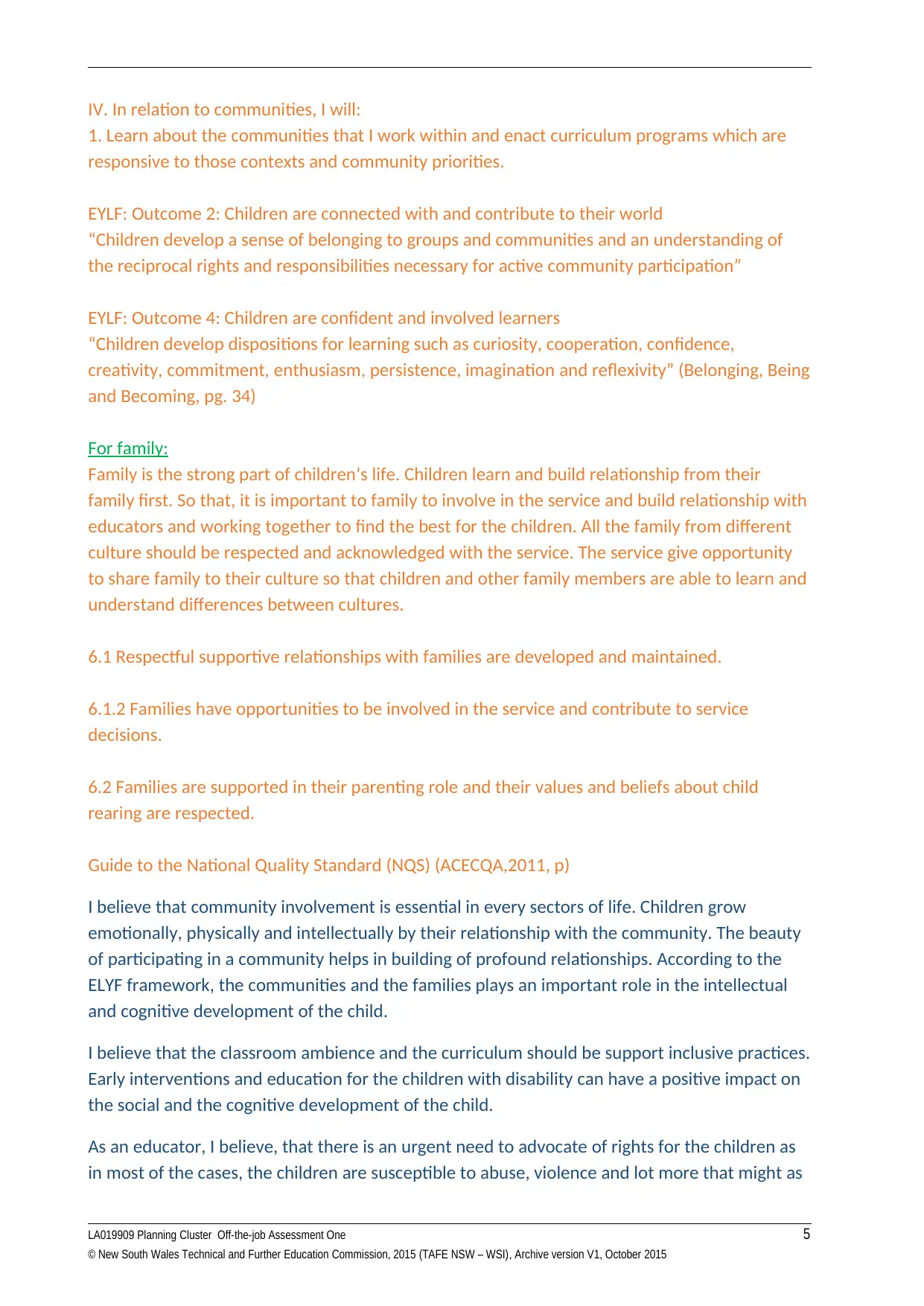
IV. In relation to communities, I will:
1. Learn about the communities that I work within and enact curriculum programs which are
responsive to those contexts and community priorities.
EYLF: Outcome 2: Children are connected with and contribute to their world
“Children develop a sense of belonging to groups and communities and an understanding of
the reciprocal rights and responsibilities necessary for active community participation”
EYLF: Outcome 4: Children are confident and involved learners
“Children develop dispositions for learning such as curiosity, cooperation, confidence,
creativity, commitment, enthusiasm, persistence, imagination and reflexivity” (Belonging, Being
and Becoming, pg. 34)
For family:
Family is the strong part of children’s life. Children learn and build relationship from their
family first. So that, it is important to family to involve in the service and build relationship with
educators and working together to find the best for the children. All the family from different
culture should be respected and acknowledged with the service. The service give opportunity
to share family to their culture so that children and other family members are able to learn and
understand differences between cultures.
6.1 Respectful supportive relationships with families are developed and maintained.
6.1.2 Families have opportunities to be involved in the service and contribute to service
decisions.
6.2 Families are supported in their parenting role and their values and beliefs about child
rearing are respected.
Guide to the National Quality Standard (NQS) (ACECQA,2011, p)
I believe that community involvement is essential in every sectors of life. Children grow
emotionally, physically and intellectually by their relationship with the community. The beauty
of participating in a community helps in building of profound relationships. According to the
ELYF framework, the communities and the families plays an important role in the intellectual
and cognitive development of the child.
I believe that the classroom ambience and the curriculum should be support inclusive practices.
Early interventions and education for the children with disability can have a positive impact on
the social and the cognitive development of the child.
As an educator, I believe, that there is an urgent need to advocate of rights for the children as
in most of the cases, the children are susceptible to abuse, violence and lot more that might as
LA019909 Planning Cluster Off-the-job Assessment One 5
© New South Wales Technical and Further Education Commission, 2015 (TAFE NSW – WSI), Archive version V1, October 2015
1. Learn about the communities that I work within and enact curriculum programs which are
responsive to those contexts and community priorities.
EYLF: Outcome 2: Children are connected with and contribute to their world
“Children develop a sense of belonging to groups and communities and an understanding of
the reciprocal rights and responsibilities necessary for active community participation”
EYLF: Outcome 4: Children are confident and involved learners
“Children develop dispositions for learning such as curiosity, cooperation, confidence,
creativity, commitment, enthusiasm, persistence, imagination and reflexivity” (Belonging, Being
and Becoming, pg. 34)
For family:
Family is the strong part of children’s life. Children learn and build relationship from their
family first. So that, it is important to family to involve in the service and build relationship with
educators and working together to find the best for the children. All the family from different
culture should be respected and acknowledged with the service. The service give opportunity
to share family to their culture so that children and other family members are able to learn and
understand differences between cultures.
6.1 Respectful supportive relationships with families are developed and maintained.
6.1.2 Families have opportunities to be involved in the service and contribute to service
decisions.
6.2 Families are supported in their parenting role and their values and beliefs about child
rearing are respected.
Guide to the National Quality Standard (NQS) (ACECQA,2011, p)
I believe that community involvement is essential in every sectors of life. Children grow
emotionally, physically and intellectually by their relationship with the community. The beauty
of participating in a community helps in building of profound relationships. According to the
ELYF framework, the communities and the families plays an important role in the intellectual
and cognitive development of the child.
I believe that the classroom ambience and the curriculum should be support inclusive practices.
Early interventions and education for the children with disability can have a positive impact on
the social and the cognitive development of the child.
As an educator, I believe, that there is an urgent need to advocate of rights for the children as
in most of the cases, the children are susceptible to abuse, violence and lot more that might as
LA019909 Planning Cluster Off-the-job Assessment One 5
© New South Wales Technical and Further Education Commission, 2015 (TAFE NSW – WSI), Archive version V1, October 2015
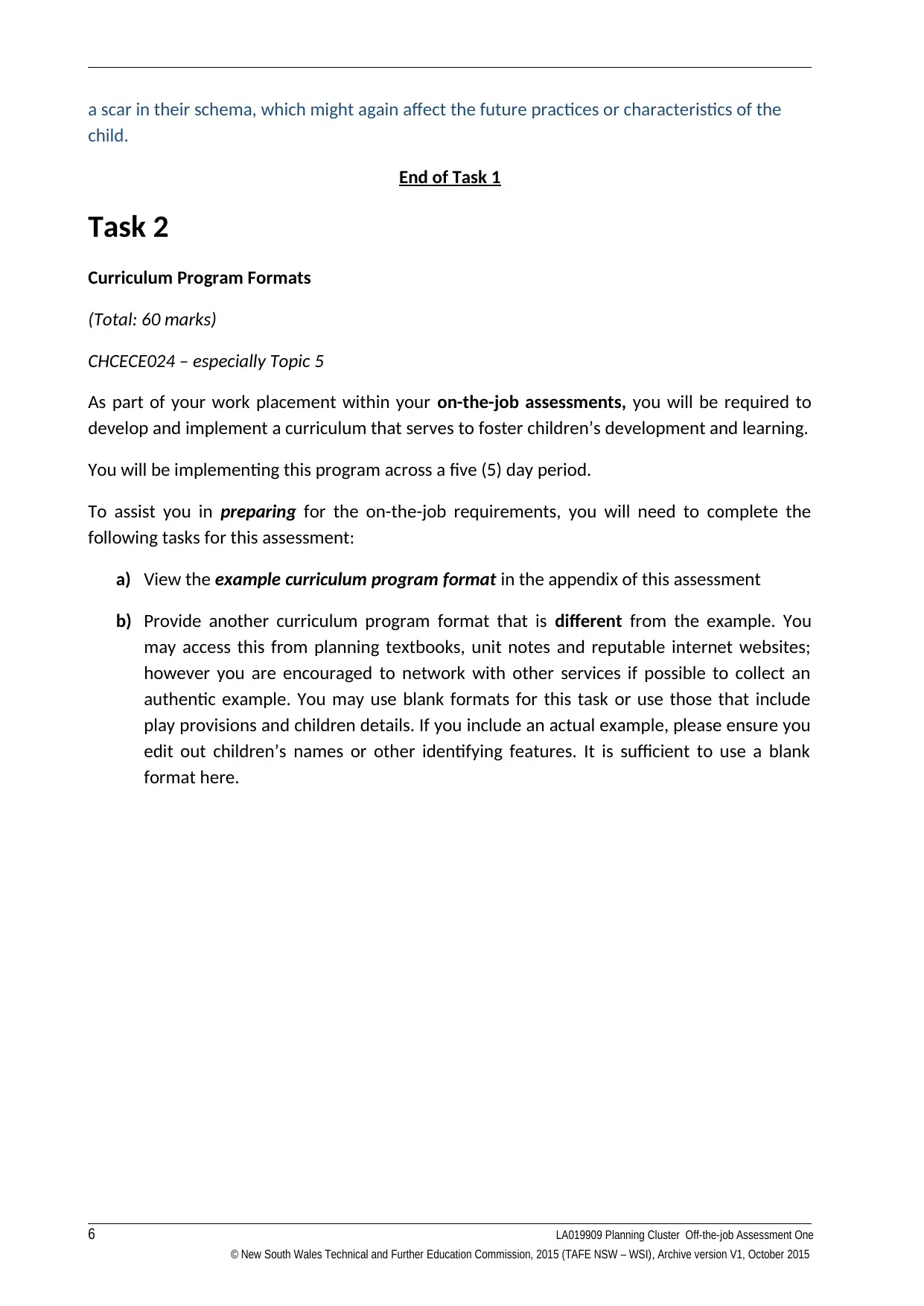
a scar in their schema, which might again affect the future practices or characteristics of the
child.
End of Task 1
Task 2
Curriculum Program Formats
(Total: 60 marks)
CHCECE024 – especially Topic 5
As part of your work placement within your on-the-job assessments, you will be required to
develop and implement a curriculum that serves to foster children’s development and learning.
You will be implementing this program across a five (5) day period.
To assist you in preparing for the on-the-job requirements, you will need to complete the
following tasks for this assessment:
a) View the example curriculum program format in the appendix of this assessment
b) Provide another curriculum program format that is different from the example. You
may access this from planning textbooks, unit notes and reputable internet websites;
however you are encouraged to network with other services if possible to collect an
authentic example. You may use blank formats for this task or use those that include
play provisions and children details. If you include an actual example, please ensure you
edit out children’s names or other identifying features. It is sufficient to use a blank
format here.
6 LA019909 Planning Cluster Off-the-job Assessment One
© New South Wales Technical and Further Education Commission, 2015 (TAFE NSW – WSI), Archive version V1, October 2015
child.
End of Task 1
Task 2
Curriculum Program Formats
(Total: 60 marks)
CHCECE024 – especially Topic 5
As part of your work placement within your on-the-job assessments, you will be required to
develop and implement a curriculum that serves to foster children’s development and learning.
You will be implementing this program across a five (5) day period.
To assist you in preparing for the on-the-job requirements, you will need to complete the
following tasks for this assessment:
a) View the example curriculum program format in the appendix of this assessment
b) Provide another curriculum program format that is different from the example. You
may access this from planning textbooks, unit notes and reputable internet websites;
however you are encouraged to network with other services if possible to collect an
authentic example. You may use blank formats for this task or use those that include
play provisions and children details. If you include an actual example, please ensure you
edit out children’s names or other identifying features. It is sufficient to use a blank
format here.
6 LA019909 Planning Cluster Off-the-job Assessment One
© New South Wales Technical and Further Education Commission, 2015 (TAFE NSW – WSI), Archive version V1, October 2015
⊘ This is a preview!⊘
Do you want full access?
Subscribe today to unlock all pages.

Trusted by 1+ million students worldwide

Our Curriculum Plan
Week Commencing: 23/1/19-3/2/19 Room: Preschool
Goal: Transition program – final two weeks
Principles- Ongoing learning and reflective practice Practices –
Responsiveness to children
Sensory play Exploratory
play
Manipulative play Dramatic play
Monday Add materials,
figurines of
animals,
encouraging
children to share
on the ideas
L/O- 2.4
I-
Photos, mind
maps,
discussion of
the child X’s
understanding
about the
experiences.
Document in
portfolio
L/o- 5.3
I-
X- hypothetical
child
Extra blocks and
pipes in the sand
pit
Adding large animal
figurines
L/O-3.1
I-
Animal dress ups in the
home corner and
creation of the animal
masks within the home
corner
L/O- 1.1
I-
Tuesday Cooking-
encouraging
children to peel
and shred
vegetables
L/O- 4.1
I-
Outdoor play
L/O- 2.4
I-
Fine motor skill
resources for Y
L/O- 3.1
I-
Y- hypothetical
child
Teaching children with
various social etiquettes,
please , thank you
L/O- 1.1
I-
Wednesday Creating a height
chart.
Group time –
brainstorming
of the ideas
Computer learning
L/O- 5.5
Train table and train set-
addition of the train
tracks
LA019909 Planning Cluster Off-the-job Assessment One 7
© New South Wales Technical and Further Education Commission, 2015 (TAFE NSW – WSI), Archive version V1, October 2015
Week Commencing: 23/1/19-3/2/19 Room: Preschool
Goal: Transition program – final two weeks
Principles- Ongoing learning and reflective practice Practices –
Responsiveness to children
Sensory play Exploratory
play
Manipulative play Dramatic play
Monday Add materials,
figurines of
animals,
encouraging
children to share
on the ideas
L/O- 2.4
I-
Photos, mind
maps,
discussion of
the child X’s
understanding
about the
experiences.
Document in
portfolio
L/o- 5.3
I-
X- hypothetical
child
Extra blocks and
pipes in the sand
pit
Adding large animal
figurines
L/O-3.1
I-
Animal dress ups in the
home corner and
creation of the animal
masks within the home
corner
L/O- 1.1
I-
Tuesday Cooking-
encouraging
children to peel
and shred
vegetables
L/O- 4.1
I-
Outdoor play
L/O- 2.4
I-
Fine motor skill
resources for Y
L/O- 3.1
I-
Y- hypothetical
child
Teaching children with
various social etiquettes,
please , thank you
L/O- 1.1
I-
Wednesday Creating a height
chart.
Group time –
brainstorming
of the ideas
Computer learning
L/O- 5.5
Train table and train set-
addition of the train
tracks
LA019909 Planning Cluster Off-the-job Assessment One 7
© New South Wales Technical and Further Education Commission, 2015 (TAFE NSW – WSI), Archive version V1, October 2015
Paraphrase This Document
Need a fresh take? Get an instant paraphrase of this document with our AI Paraphraser
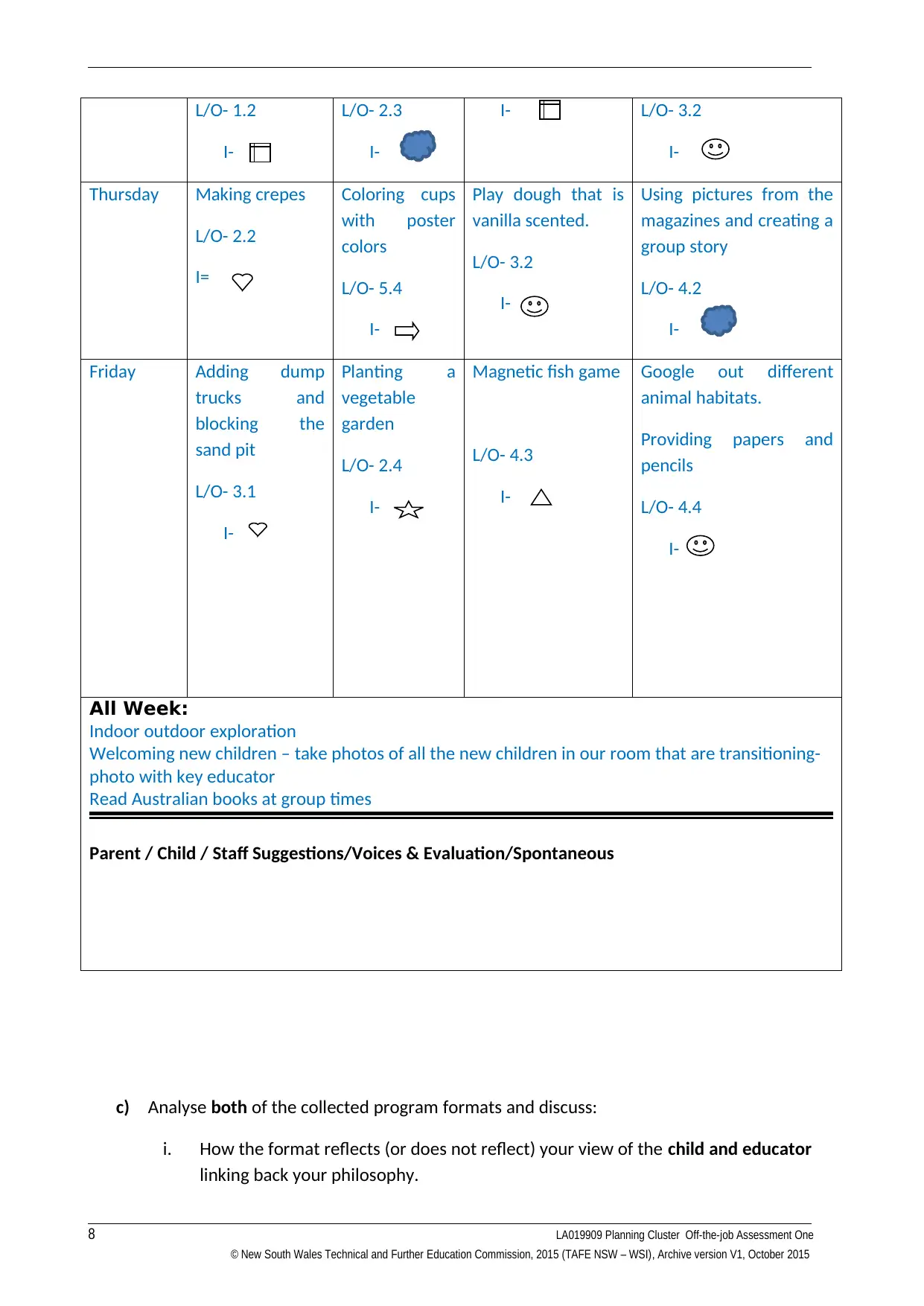
L/O- 1.2
I-
L/O- 2.3
I-
I- L/O- 3.2
I-
Thursday Making crepes
L/O- 2.2
I=
Coloring cups
with poster
colors
L/O- 5.4
I-
Play dough that is
vanilla scented.
L/O- 3.2
I-
Using pictures from the
magazines and creating a
group story
L/O- 4.2
I-
Friday Adding dump
trucks and
blocking the
sand pit
L/O- 3.1
I-
Planting a
vegetable
garden
L/O- 2.4
I-
Magnetic fish game
L/O- 4.3
I-
Google out different
animal habitats.
Providing papers and
pencils
L/O- 4.4
I-
All Week:
Indoor outdoor exploration
Welcoming new children – take photos of all the new children in our room that are transitioning-
photo with key educator
Read Australian books at group times
Parent / Child / Staff Suggestions/Voices & Evaluation/Spontaneous
c) Analyse both of the collected program formats and discuss:
i. How the format reflects (or does not reflect) your view of the child and educator
linking back your philosophy.
8 LA019909 Planning Cluster Off-the-job Assessment One
© New South Wales Technical and Further Education Commission, 2015 (TAFE NSW – WSI), Archive version V1, October 2015
I-
L/O- 2.3
I-
I- L/O- 3.2
I-
Thursday Making crepes
L/O- 2.2
I=
Coloring cups
with poster
colors
L/O- 5.4
I-
Play dough that is
vanilla scented.
L/O- 3.2
I-
Using pictures from the
magazines and creating a
group story
L/O- 4.2
I-
Friday Adding dump
trucks and
blocking the
sand pit
L/O- 3.1
I-
Planting a
vegetable
garden
L/O- 2.4
I-
Magnetic fish game
L/O- 4.3
I-
Google out different
animal habitats.
Providing papers and
pencils
L/O- 4.4
I-
All Week:
Indoor outdoor exploration
Welcoming new children – take photos of all the new children in our room that are transitioning-
photo with key educator
Read Australian books at group times
Parent / Child / Staff Suggestions/Voices & Evaluation/Spontaneous
c) Analyse both of the collected program formats and discuss:
i. How the format reflects (or does not reflect) your view of the child and educator
linking back your philosophy.
8 LA019909 Planning Cluster Off-the-job Assessment One
© New South Wales Technical and Further Education Commission, 2015 (TAFE NSW – WSI), Archive version V1, October 2015
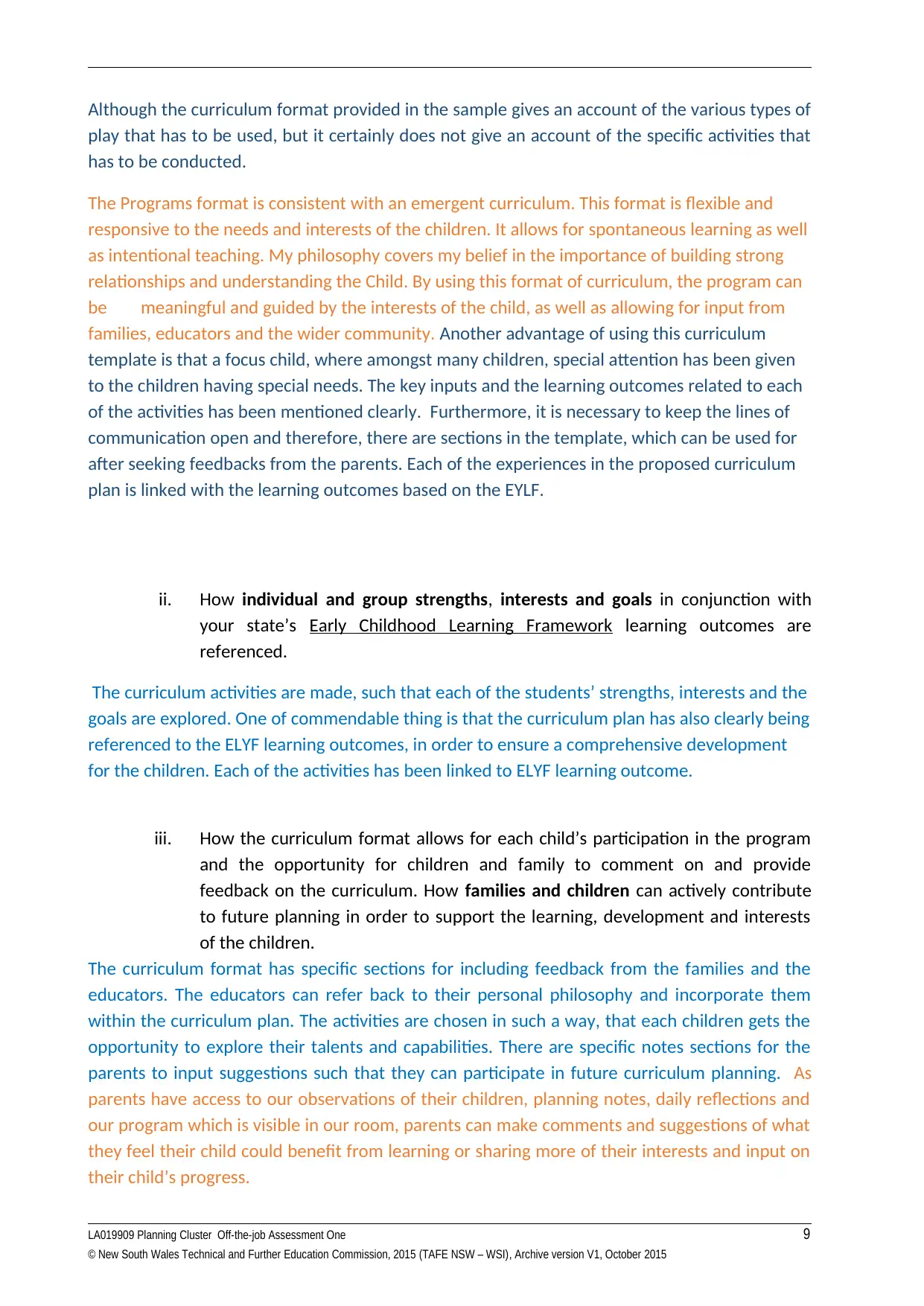
Although the curriculum format provided in the sample gives an account of the various types of
play that has to be used, but it certainly does not give an account of the specific activities that
has to be conducted.
The Programs format is consistent with an emergent curriculum. This format is flexible and
responsive to the needs and interests of the children. It allows for spontaneous learning as well
as intentional teaching. My philosophy covers my belief in the importance of building strong
relationships and understanding the Child. By using this format of curriculum, the program can
be meaningful and guided by the interests of the child, as well as allowing for input from
families, educators and the wider community. Another advantage of using this curriculum
template is that a focus child, where amongst many children, special attention has been given
to the children having special needs. The key inputs and the learning outcomes related to each
of the activities has been mentioned clearly. Furthermore, it is necessary to keep the lines of
communication open and therefore, there are sections in the template, which can be used for
after seeking feedbacks from the parents. Each of the experiences in the proposed curriculum
plan is linked with the learning outcomes based on the EYLF.
ii. How individual and group strengths, interests and goals in conjunction with
your state’s Early Childhood Learning Framework learning outcomes are
referenced.
The curriculum activities are made, such that each of the students’ strengths, interests and the
goals are explored. One of commendable thing is that the curriculum plan has also clearly being
referenced to the ELYF learning outcomes, in order to ensure a comprehensive development
for the children. Each of the activities has been linked to ELYF learning outcome.
iii. How the curriculum format allows for each child’s participation in the program
and the opportunity for children and family to comment on and provide
feedback on the curriculum. How families and children can actively contribute
to future planning in order to support the learning, development and interests
of the children.
The curriculum format has specific sections for including feedback from the families and the
educators. The educators can refer back to their personal philosophy and incorporate them
within the curriculum plan. The activities are chosen in such a way, that each children gets the
opportunity to explore their talents and capabilities. There are specific notes sections for the
parents to input suggestions such that they can participate in future curriculum planning. As
parents have access to our observations of their children, planning notes, daily reflections and
our program which is visible in our room, parents can make comments and suggestions of what
they feel their child could benefit from learning or sharing more of their interests and input on
their child’s progress.
LA019909 Planning Cluster Off-the-job Assessment One 9
© New South Wales Technical and Further Education Commission, 2015 (TAFE NSW – WSI), Archive version V1, October 2015
play that has to be used, but it certainly does not give an account of the specific activities that
has to be conducted.
The Programs format is consistent with an emergent curriculum. This format is flexible and
responsive to the needs and interests of the children. It allows for spontaneous learning as well
as intentional teaching. My philosophy covers my belief in the importance of building strong
relationships and understanding the Child. By using this format of curriculum, the program can
be meaningful and guided by the interests of the child, as well as allowing for input from
families, educators and the wider community. Another advantage of using this curriculum
template is that a focus child, where amongst many children, special attention has been given
to the children having special needs. The key inputs and the learning outcomes related to each
of the activities has been mentioned clearly. Furthermore, it is necessary to keep the lines of
communication open and therefore, there are sections in the template, which can be used for
after seeking feedbacks from the parents. Each of the experiences in the proposed curriculum
plan is linked with the learning outcomes based on the EYLF.
ii. How individual and group strengths, interests and goals in conjunction with
your state’s Early Childhood Learning Framework learning outcomes are
referenced.
The curriculum activities are made, such that each of the students’ strengths, interests and the
goals are explored. One of commendable thing is that the curriculum plan has also clearly being
referenced to the ELYF learning outcomes, in order to ensure a comprehensive development
for the children. Each of the activities has been linked to ELYF learning outcome.
iii. How the curriculum format allows for each child’s participation in the program
and the opportunity for children and family to comment on and provide
feedback on the curriculum. How families and children can actively contribute
to future planning in order to support the learning, development and interests
of the children.
The curriculum format has specific sections for including feedback from the families and the
educators. The educators can refer back to their personal philosophy and incorporate them
within the curriculum plan. The activities are chosen in such a way, that each children gets the
opportunity to explore their talents and capabilities. There are specific notes sections for the
parents to input suggestions such that they can participate in future curriculum planning. As
parents have access to our observations of their children, planning notes, daily reflections and
our program which is visible in our room, parents can make comments and suggestions of what
they feel their child could benefit from learning or sharing more of their interests and input on
their child’s progress.
LA019909 Planning Cluster Off-the-job Assessment One 9
© New South Wales Technical and Further Education Commission, 2015 (TAFE NSW – WSI), Archive version V1, October 2015
⊘ This is a preview!⊘
Do you want full access?
Subscribe today to unlock all pages.

Trusted by 1+ million students worldwide
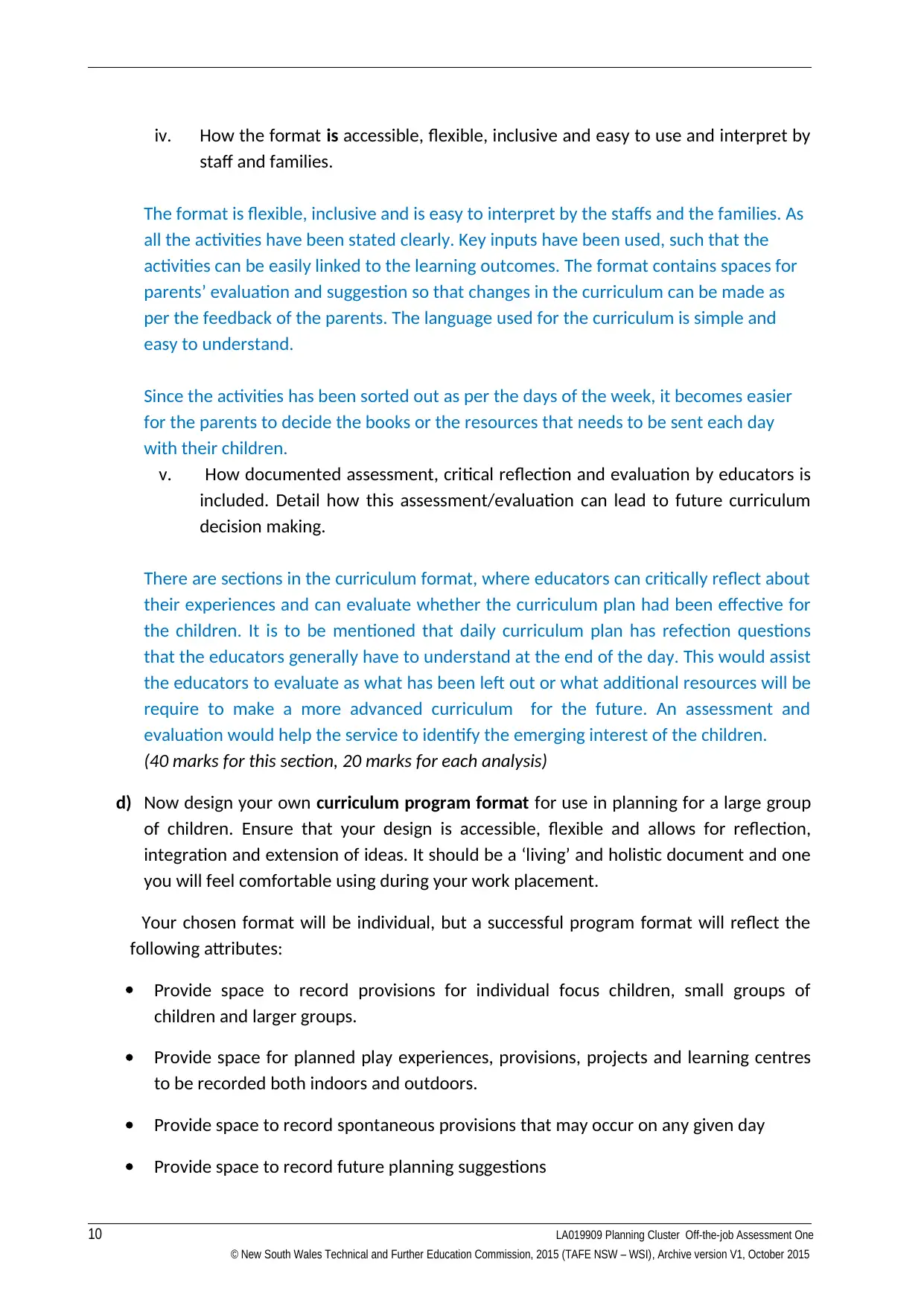
iv. How the format is accessible, flexible, inclusive and easy to use and interpret by
staff and families.
The format is flexible, inclusive and is easy to interpret by the staffs and the families. As
all the activities have been stated clearly. Key inputs have been used, such that the
activities can be easily linked to the learning outcomes. The format contains spaces for
parents’ evaluation and suggestion so that changes in the curriculum can be made as
per the feedback of the parents. The language used for the curriculum is simple and
easy to understand.
Since the activities has been sorted out as per the days of the week, it becomes easier
for the parents to decide the books or the resources that needs to be sent each day
with their children.
v. How documented assessment, critical reflection and evaluation by educators is
included. Detail how this assessment/evaluation can lead to future curriculum
decision making.
There are sections in the curriculum format, where educators can critically reflect about
their experiences and can evaluate whether the curriculum plan had been effective for
the children. It is to be mentioned that daily curriculum plan has refection questions
that the educators generally have to understand at the end of the day. This would assist
the educators to evaluate as what has been left out or what additional resources will be
require to make a more advanced curriculum for the future. An assessment and
evaluation would help the service to identify the emerging interest of the children.
(40 marks for this section, 20 marks for each analysis)
d) Now design your own curriculum program format for use in planning for a large group
of children. Ensure that your design is accessible, flexible and allows for reflection,
integration and extension of ideas. It should be a ‘living’ and holistic document and one
you will feel comfortable using during your work placement.
Your chosen format will be individual, but a successful program format will reflect the
following attributes:
Provide space to record provisions for individual focus children, small groups of
children and larger groups.
Provide space for planned play experiences, provisions, projects and learning centres
to be recorded both indoors and outdoors.
Provide space to record spontaneous provisions that may occur on any given day
Provide space to record future planning suggestions
10 LA019909 Planning Cluster Off-the-job Assessment One
© New South Wales Technical and Further Education Commission, 2015 (TAFE NSW – WSI), Archive version V1, October 2015
staff and families.
The format is flexible, inclusive and is easy to interpret by the staffs and the families. As
all the activities have been stated clearly. Key inputs have been used, such that the
activities can be easily linked to the learning outcomes. The format contains spaces for
parents’ evaluation and suggestion so that changes in the curriculum can be made as
per the feedback of the parents. The language used for the curriculum is simple and
easy to understand.
Since the activities has been sorted out as per the days of the week, it becomes easier
for the parents to decide the books or the resources that needs to be sent each day
with their children.
v. How documented assessment, critical reflection and evaluation by educators is
included. Detail how this assessment/evaluation can lead to future curriculum
decision making.
There are sections in the curriculum format, where educators can critically reflect about
their experiences and can evaluate whether the curriculum plan had been effective for
the children. It is to be mentioned that daily curriculum plan has refection questions
that the educators generally have to understand at the end of the day. This would assist
the educators to evaluate as what has been left out or what additional resources will be
require to make a more advanced curriculum for the future. An assessment and
evaluation would help the service to identify the emerging interest of the children.
(40 marks for this section, 20 marks for each analysis)
d) Now design your own curriculum program format for use in planning for a large group
of children. Ensure that your design is accessible, flexible and allows for reflection,
integration and extension of ideas. It should be a ‘living’ and holistic document and one
you will feel comfortable using during your work placement.
Your chosen format will be individual, but a successful program format will reflect the
following attributes:
Provide space to record provisions for individual focus children, small groups of
children and larger groups.
Provide space for planned play experiences, provisions, projects and learning centres
to be recorded both indoors and outdoors.
Provide space to record spontaneous provisions that may occur on any given day
Provide space to record future planning suggestions
10 LA019909 Planning Cluster Off-the-job Assessment One
© New South Wales Technical and Further Education Commission, 2015 (TAFE NSW – WSI), Archive version V1, October 2015
Paraphrase This Document
Need a fresh take? Get an instant paraphrase of this document with our AI Paraphraser
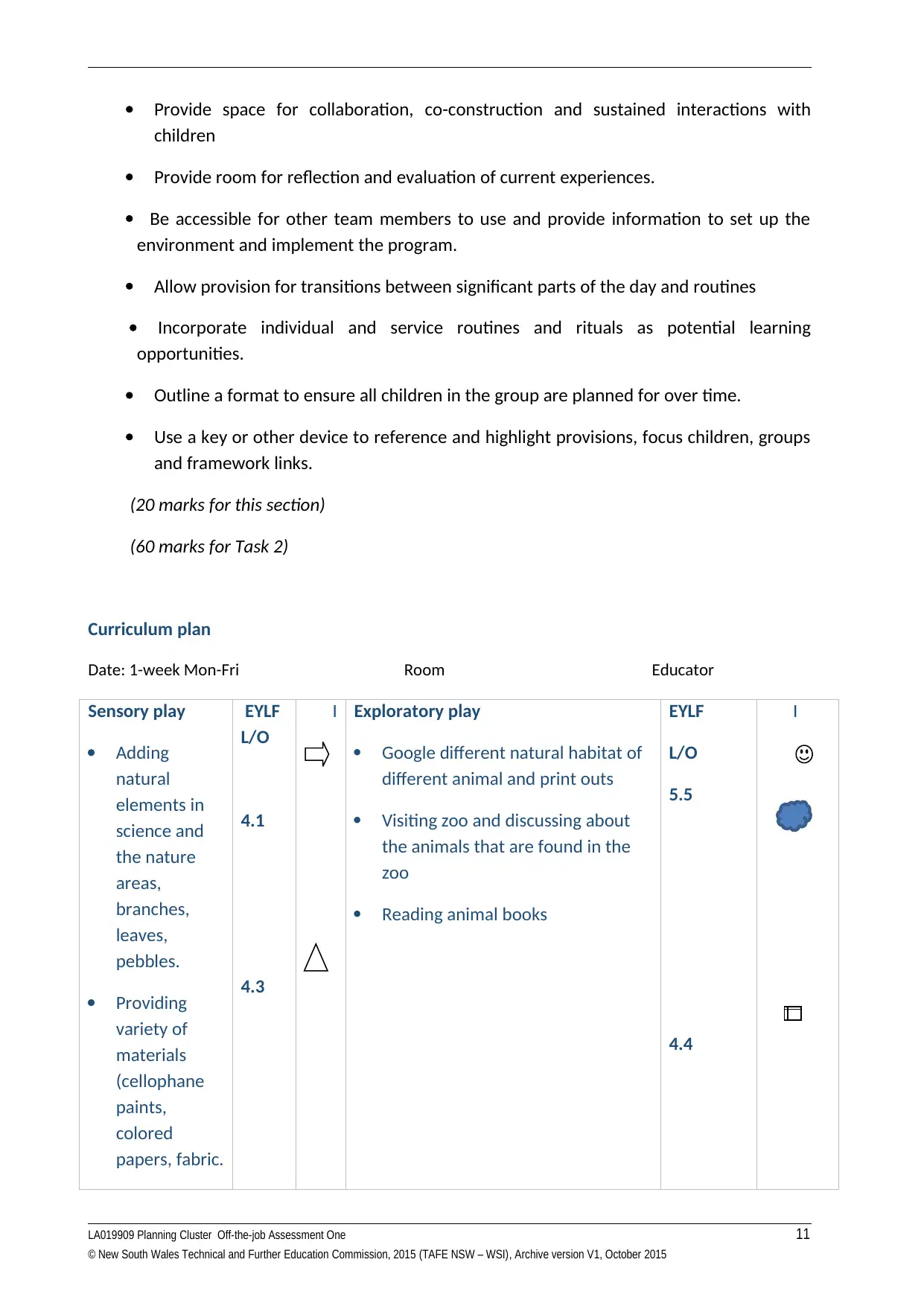
Provide space for collaboration, co-construction and sustained interactions with
children
Provide room for reflection and evaluation of current experiences.
Be accessible for other team members to use and provide information to set up the
environment and implement the program.
Allow provision for transitions between significant parts of the day and routines
Incorporate individual and service routines and rituals as potential learning
opportunities.
Outline a format to ensure all children in the group are planned for over time.
Use a key or other device to reference and highlight provisions, focus children, groups
and framework links.
(20 marks for this section)
(60 marks for Task 2)
Curriculum plan
Date: 1-week Mon-Fri Room Educator
Sensory play
Adding
natural
elements in
science and
the nature
areas,
branches,
leaves,
pebbles.
Providing
variety of
materials
(cellophane
paints,
colored
papers, fabric.
EYLF
L/O
4.1
4.3
I Exploratory play
Google different natural habitat of
different animal and print outs
Visiting zoo and discussing about
the animals that are found in the
zoo
Reading animal books
EYLF
L/O
5.5
4.4
I
LA019909 Planning Cluster Off-the-job Assessment One 11
© New South Wales Technical and Further Education Commission, 2015 (TAFE NSW – WSI), Archive version V1, October 2015
children
Provide room for reflection and evaluation of current experiences.
Be accessible for other team members to use and provide information to set up the
environment and implement the program.
Allow provision for transitions between significant parts of the day and routines
Incorporate individual and service routines and rituals as potential learning
opportunities.
Outline a format to ensure all children in the group are planned for over time.
Use a key or other device to reference and highlight provisions, focus children, groups
and framework links.
(20 marks for this section)
(60 marks for Task 2)
Curriculum plan
Date: 1-week Mon-Fri Room Educator
Sensory play
Adding
natural
elements in
science and
the nature
areas,
branches,
leaves,
pebbles.
Providing
variety of
materials
(cellophane
paints,
colored
papers, fabric.
EYLF
L/O
4.1
4.3
I Exploratory play
Google different natural habitat of
different animal and print outs
Visiting zoo and discussing about
the animals that are found in the
zoo
Reading animal books
EYLF
L/O
5.5
4.4
I
LA019909 Planning Cluster Off-the-job Assessment One 11
© New South Wales Technical and Further Education Commission, 2015 (TAFE NSW – WSI), Archive version V1, October 2015
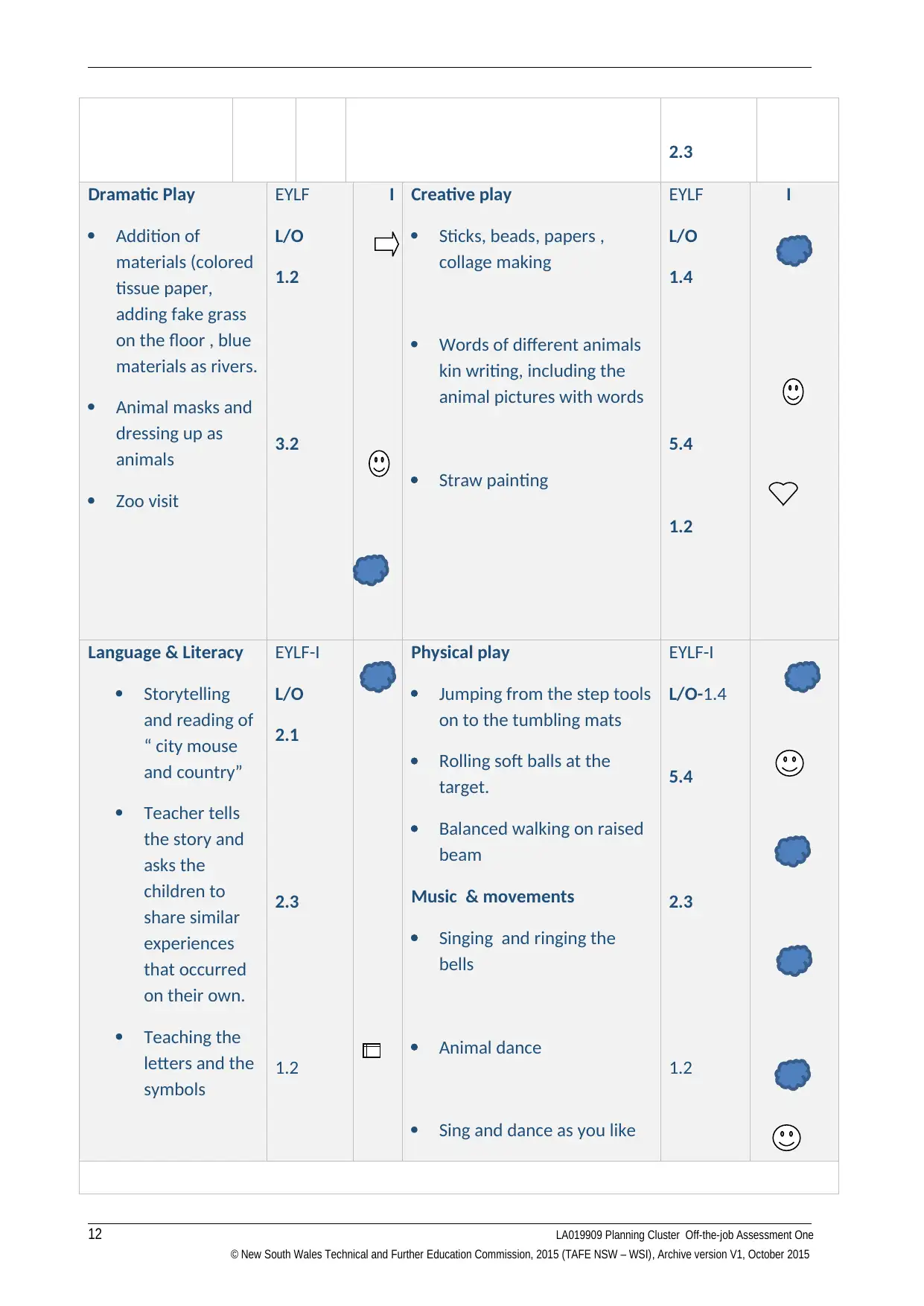
2.3
Dramatic Play
Addition of
materials (colored
tissue paper,
adding fake grass
on the floor , blue
materials as rivers.
Animal masks and
dressing up as
animals
Zoo visit
EYLF
L/O
1.2
3.2
I Creative play
Sticks, beads, papers ,
collage making
Words of different animals
kin writing, including the
animal pictures with words
Straw painting
EYLF
L/O
1.4
5.4
1.2
I
Language & Literacy
Storytelling
and reading of
“ city mouse
and country”
Teacher tells
the story and
asks the
children to
share similar
experiences
that occurred
on their own.
Teaching the
letters and the
symbols
EYLF-I
L/O
2.1
2.3
1.2
Physical play
Jumping from the step tools
on to the tumbling mats
Rolling soft balls at the
target.
Balanced walking on raised
beam
Music & movements
Singing and ringing the
bells
Animal dance
Sing and dance as you like
EYLF-I
L/O-1.4
5.4
2.3
1.2
12 LA019909 Planning Cluster Off-the-job Assessment One
© New South Wales Technical and Further Education Commission, 2015 (TAFE NSW – WSI), Archive version V1, October 2015
Dramatic Play
Addition of
materials (colored
tissue paper,
adding fake grass
on the floor , blue
materials as rivers.
Animal masks and
dressing up as
animals
Zoo visit
EYLF
L/O
1.2
3.2
I Creative play
Sticks, beads, papers ,
collage making
Words of different animals
kin writing, including the
animal pictures with words
Straw painting
EYLF
L/O
1.4
5.4
1.2
I
Language & Literacy
Storytelling
and reading of
“ city mouse
and country”
Teacher tells
the story and
asks the
children to
share similar
experiences
that occurred
on their own.
Teaching the
letters and the
symbols
EYLF-I
L/O
2.1
2.3
1.2
Physical play
Jumping from the step tools
on to the tumbling mats
Rolling soft balls at the
target.
Balanced walking on raised
beam
Music & movements
Singing and ringing the
bells
Animal dance
Sing and dance as you like
EYLF-I
L/O-1.4
5.4
2.3
1.2
12 LA019909 Planning Cluster Off-the-job Assessment One
© New South Wales Technical and Further Education Commission, 2015 (TAFE NSW – WSI), Archive version V1, October 2015
⊘ This is a preview!⊘
Do you want full access?
Subscribe today to unlock all pages.

Trusted by 1+ million students worldwide
1 out of 37
Related Documents
Your All-in-One AI-Powered Toolkit for Academic Success.
+13062052269
info@desklib.com
Available 24*7 on WhatsApp / Email
![[object Object]](/_next/static/media/star-bottom.7253800d.svg)
Unlock your academic potential
Copyright © 2020–2025 A2Z Services. All Rights Reserved. Developed and managed by ZUCOL.





